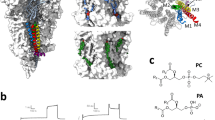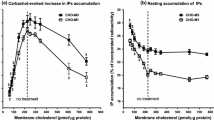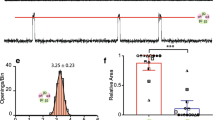Abstract
The nicotinic acetylcholine receptor (nAChR), located in the cell membranes of neurons and muscle cells, mediates the transmission of nerve impulses across cholinergic synapses. In addition, the nAChR is also found in the electric organs of electric rays (e.g., the genus Torpedo). Cholesterol, which is a key lipid for maintaining the correct functionality of membrane proteins, has been found to alter the nAChR function. We were thus interested to probe the changes in the functionality of different nAChRs expressed in a model membrane with modified cholesterol to phospholipid ratios (C/P). In this study, we examined the effect of increasing the C/P ratio in Xenopus laevis oocytes expressing the neuronal α7, α4β2, muscle-type, and Torpedo californica nAChRs in their macroscopic current responses. Using the two-electrode voltage clamp technique, it was found that the neuronal α7 and Torpedo nAChRs are significantly more sensitive to small increases in C/P than the muscle-type nAChR. The peak current versus C/P profiles during enrichment display different behaviors; α7 and Torpedo nAChRs display a hyperbolic decay with two clear components, whereas muscle-type and α4β2 nAChRs display simple monophasic decays with different slopes. This study clearly illustrates that a physiologically relevant increase in membrane cholesterol concentration produces a remarkable reduction in the macroscopic current responses of the neuronal α7 and Torpedo nAChRs functionality, whereas the muscle nAChR appears to be the most resistant to cholesterol inhibition among all four nAChR subtypes. Overall, the present study demonstrates differential profiles for cholesterol inhibition among the different types of nAChR to physiological cholesterol increments in the plasmatic membrane. This is the first study to report a cross-correlation analysis of cholesterol sensitivity among different nAChR subtypes in a model membrane.





Similar content being viewed by others
Abbreviations
- nAChR:
-
Nicotinic acetylcholine receptor
- WT:
-
Wild type
- ACh:
-
Acetylcholine
- α-BTX:
-
α-Bungarotoxin
References
Abi-Char J, Maguy A, Coulombe A et al (2007) Membrane cholesterol modulates Kv1.5 potassium channel distribution and function in rat cardiomyocytes. J Physiol 582:1205–1217. doi:10.1113/jphysiol.2007.134809
Addona GH, Sandermann H, Kloczewiak MA et al (1998) Where does cholesterol act during activation of the nicotinic acetylcholine receptor? Biochim Biophys Acta 1370:299–309
Antollini SS, Barrantes FJ (1998) Disclosure of discrete sites for phospholipid and sterols at the protein-lipid interface in native acetylcholine receptor-rich membrane. Biochemistry (Mosc) 37:16653–16662. doi:10.1021/bi9808215
Baenziger JE, Morris ML, Darsaut TE, Ryan SE (2000) Effect of membrane lipid composition on the conformational equilibria of the nicotinic acetylcholine receptor. J Biol Chem 275:777–784
Báez-Pagán CA, Martínez-Ortiz Y, Otero-Cruz JD et al (2008) Potential role of caveolin-1-positive domains in the regulation of the acetylcholine receptor’s activatable pool: implications in the pathogenesis of a novel congenital myasthenic syndrome. Channels Austin Tex 2:180–190
Barbuti A, Gravante B, Riolfo M et al (2004) Localization of pacemaker channels in lipid rafts regulates channel kinetics. Circ Res 94:1325–1331. doi:10.1161/01.RES.0000127621.54132.AE
Barrantes FJ (2002) Lipid matters: nicotinic acetylcholine receptor-lipid interactions (Review). Mol Membr Biol 19:277–284. doi:10.1080/09687680210166226
Barrantes FJ (2004) Structural basis for lipid modulation of nicotinic acetylcholine receptor function. Brain Res Brain Res Rev 47:71–95. doi:10.1016/j.brainresrev.2004.06.008
Barrantes FJ, Borroni V, Vallés S (2010) Neuronal nicotinic acetylcholine receptor-cholesterol crosstalk in Alzheimer’s disease. FEBS Lett 584:1856–1863. doi:10.1016/j.febslet.2009.11.036
Brannigan G, Hénin J, Law R et al (2008) Embedded cholesterol in the nicotinic acetylcholine receptor. Proc Natl Acad Sci USA 105:14418–14423. doi:10.1073/pnas.0803029105
Brusés JL, Chauvet N, Rutishauser U (2001) Membrane lipid rafts are necessary for the maintenance of the (alpha)7 nicotinic acetylcholine receptor in somatic spines of ciliary neurons. J Neurosci Off J Soc Neurosci 21:504–512
Burger K, Gimpl G, Fahrenholz F (2000) Regulation of receptor function by cholesterol. Cell Mol Life Sci CMLS 57:1577–1592
Cockcroft VB, Osguthorpe DJ, Barnard EA et al (1990) Ligand-gated ion channels. Homology and diversity. Mol Neurobiol 4:129–169. doi:10.1007/BF02780338
Cohen BM, Zubenko GS (1985) Aging and the biophysical properties of cell membranes. Life Sci 37:1403–1409
Cooper E, Couturier S, Ballivet M (1991) Pentameric structure and subunit stoichiometry of a neuronal nicotinic acetylcholine receptor. Nature 350:235–238. doi:10.1038/350235a0
Corbin J, Wang HH, Blanton MP (1998) Identifying the cholesterol binding domain in the nicotinic acetylcholine receptor with [125I]azido-cholesterol. Biochim Biophys Acta 1414:65–74
Corringer PJ, Le Novère N, Changeux JP (2000) Nicotinic receptors at the amino acid level. Annu Rev Pharmacol Toxicol 40:431–458. doi:10.1146/annurev.pharmtox.40.1.431
Dalziel AW, Rollins ES, McNamee MG (1980) The effect of cholesterol on agonist-induced flux in reconstituted acetylcholine receptor vesicles. FEBS Lett 122:193–196
Demel RA, Bruckdorfer KR, van Deenen LL (1972) The effect of sterol structure on the permeability of lipomes to glucose, glycerol and Rb +. Biochim Biophys Acta 255:321–330
Fernandez-Ballester G, Castresana J, Fernandez AM et al (1994) Role of cholesterol as a structural and functional effector of the nicotinic acetylcholine receptor. Biochem Soc Trans 22:776–780
Fong TM, McNamee MG (1986) Correlation between acetylcholine receptor function and structural properties of membranes. Biochem (Mosc) 25:830–840
Gally HU, Seelig A, Seelig J (1976) Cholesterol-induced rod-like motion of fatty acyl chains in lipid bilayers a deuterium magnetic resonance study. Hoppe-Seylers Z Für Physiol Chem 357:1447–1450
Galzi JL, Revah F, Bessis A, Changeux JP (1991) Functional architecture of the nicotinic acetylcholine receptor: from electric organ to brain. Annu Rev Pharmacol Toxicol 31:37–72. doi:10.1146/annurev.pa.31.040191.000345
Gonzalez-Ros JM, Llanillo M, Paraschos A, Martinez-Carrion M (1982) Lipid environment of acetylcholine receptor from Torpedo californica. Biochem (Mosc) 21:3467–3474
Grajales-Reyes GE, Báez-Pagán CA, Zhu H et al (2013) Transgenic mouse model reveals an unsuspected role of the acetylcholine receptor in statin-induced neuromuscular adverse drug reactions. Pharmacogenomics J 13:362–368. doi:10.1038/tpj.2012.21
Guzmán GR, Ortiz-Acevedo A, Ricardo A et al (2006) The polarity of lipid-exposed residues contributes to the functional differences between Torpedo and muscle-type nicotinic receptors. J Membr Biol 214:131–138. doi:10.1007/s00232-006-0051-0
Hamouda AK, Sanghvi M, Sauls D et al (2006) Assessing the lipid requirements of the Torpedo californica nicotinic acetylcholine receptor. Biochem (Mosc) 45:4327–4337. doi:10.1021/bi052281z
Ikonen E, Heino S, Lusa S (2004) Caveolins and membrane cholesterol. Biochem Soc Trans 32:121–123. doi:10.1042/bst0320121
Itier V, Bertrand D (2001) Neuronal nicotinic receptors: from protein structure to function. FEBS Lett 504:118–125
Jensen MØ, Mouritsen OG (2004) Lipids do influence protein function-the hydrophobic matching hypothesis revisited. Biochim Biophys Acta 1666:205–226. doi:10.1016/j.bbamem.2004.06.009
Jones OT, McNamee MG (1988) Annular and nonannular binding sites for cholesterol associated with the nicotinic acetylcholine receptor. Biochem (Mosc) 27:2364–2374
Kalamida D, Poulas K, Avramopoulou V et al (2007) Muscle and neuronal nicotinic acetylcholine receptors. Structure, function and pathogenicity. FEBS J 274:3799–3845. doi:10.1111/j.1742-4658.2007.05935.x
Karlin A (2002) Emerging structure of the nicotinic acetylcholine receptors. Nat Rev Neurosci 3:102–114. doi:10.1038/nrn731
Krainev AG, Ferrington DA, Williams TD et al (1995) Adaptive changes in lipid composition of skeletal sarcoplasmic reticulum membranes associated with aging. Biochim Biophys Acta 1235:406–418
Lasalde JA, Colom A, Resto E, Zuazaga C (1995) Heterogeneous distribution of acetylcholine receptors in chick myocytes induced by cholesterol enrichment. Biochim Biophys Acta 1235:361–368
Le Novère N, Corringer P-J, Changeux J-P (2002) The diversity of subunit composition in nAChRs: evolutionary origins, physiologic and pharmacologic consequences. J Neurobiol 53:447–456. doi:10.1002/neu.10153
Lechleiter J, Wells M, Gruener R (1986) Halothane-induced changes in acetylcholine receptor channel kinetics are attenuated by cholesterol. Biochim Biophys Acta 856:640–645
Lee AG (2003) Lipid-protein interactions in biological membranes: a structural perspective. Biochim Biophys Acta 1612:1–40
Lee YH, Li L, Lasalde J et al (1994) Mutations in the M4 domain of Torpedo californica acetylcholine receptor dramatically alter ion channel function. Biophys J 66:646–653
Leibel WS, Firestone LL, Legler DC et al (1987) Two pools of cholesterol in acetylcholine receptor-rich membranes from Torpedo. Biochim Biophys Acta 897:249–260
Marchand S, Devillers-Thiéry A, Pons S et al (2002) Rapsyn escorts the nicotinic acetylcholine receptor along the exocytic pathway via association with lipid rafts. J Neurosci Off J Soc Neurosci 22:8891–8901
McConnell HM, Radhakrishnan A (2003) Condensed complexes of cholesterol and phospholipids. Biochim Biophys Acta 1610:159–173
Middlemas DS, Raftery MA (1987) Identification of subunits of acetylcholine receptor that interact with a cholesterol photoaffinity probe. Biochem (Mosc) 26:1219–1223
Narayanaswami V, McNamee MG (1993) Protein-lipid interactions and Torpedo californica nicotinic acetylcholine receptor function. 2. Membrane fluidity and ligand-mediated alteration in the accessibility of gamma subunit cysteine residues to cholesterol. Biochem (Mosc) 32:12420–12427
O’Neill MJ, Murray TK, Lakics V et al (2002) The role of neuronal nicotinic acetylcholine receptors in acute and chronic neurodegeneration. Curr Drug Targets CNS Neurol Disord 1:399–411
Ohlsson RI, Lane CD, Guengerich FP (1981) Synthesis and insertion, both in vivo and in vitro, of rat-liver cytochrome P-450 and epoxide hydratase into Xenopus laevis membranes. Eur J Biochem FEBS 115:367–373
Oshikawa J, Toya Y, Fujita T et al (2003) Nicotinic acetylcholine receptor alpha 7 regulates cAMP signal within lipid rafts. Am J Physiol Cell Physiol 285:C567–C574. doi:10.1152/ajpcell.00422.2002
Paterson D, Nordberg A (2000) Neuronal nicotinic receptors in the human brain. Prog Neurobiol 61:75–111
Pike LJ (2006) Rafts defined: a report on the Keystone Symposium on Lipid Rafts and Cell Function. J Lipid Res 47:1597–1598. doi:10.1194/jlr.E600002-JLR200
Radhakrishnan A, McConnell HM (1999) Condensed complexes of cholesterol and phospholipids. Biophys J 77:1507–1517. doi:10.1016/S0006-3495(99)76998-5
Roher AE, Kuo YM, Kokjohn KM et al (1999) Amyloid and lipids in the pathology of Alzheimer disease. Amyloid Int J Exp Clin Investig Off J Int Soc Amyloidosis 6:136–145
Santiago J, Guzmàn GR, Rojas LV et al (2001) Probing the effects of membrane cholesterol in the Torpedo californica acetylcholine receptor and the novel lipid-exposed mutation alpha C418W in Xenopus oocytes. J Biol Chem 276:46523–46532. doi:10.1074/jbc.M104563200
Schiebler W, Hucho F (1978) Membranes rich in acetylcholine receptor: characterization and reconstitution to excitable membranes from exogenous lipids. Eur J Biochem FEBS 85:55–63
Sumikawa K, Houghton M, Emtage JS et al (1981) Active multi-subunit ACh receptor assembled by translation of heterologous mRNA in Xenopus oocytes. Nature 292:862–864
Sunshine C, McNamee MG (1992) Lipid modulation of nicotinic acetylcholine receptor function: the role of neutral and negatively charged lipids. Biochim Biophys Acta 1108:240–246
Tamamizu S, Lee Y, Hung B et al (1999) Alteration in ion channel function of mouse nicotinic acetylcholine receptor by mutations in the M4 transmembrane domain. J Membr Biol 170:157–164
Tamamizu S, Guzmán GR, Santiago J et al (2000) Functional effects of periodic tryptophan substitutions in the alpha M4 transmembrane domain of the Torpedo californica nicotinic acetylcholine receptor. Biochem (Mosc) 39:4666–4673
Wood WG, Schroeder F, Igbavboa U et al (2002) Brain membrane cholesterol domains, aging and amyloid beta-peptides. Neurobiol Aging 23:685–694
Yeagle PL (1985) Cholesterol and the cell membrane. Biochim Biophys Acta 822:267–287
Zhu D, Xiong WC, Mei L (2006) Lipid rafts serve as a signaling platform for nicotinic acetylcholine receptor clustering. J Neurosci Off J Soc Neurosci 26:4841–4851. doi:10.1523/JNEUROSCI.2807-05.2006
Acknowledgments
This research was supported by the National Institutes of Health NIGMS grants 1R01GM098343 (JALD) and 1P20GM103642 (J.R. and JALD). The content is solely the responsibility of the authors and does not necessarily represent the official views of the National Institutes of Health. Natalie del Hoyo-Rivera was supported by the UPR-RP MARC Program (Grant Number: 5T34GM07821) (OQ) and by the NIH-MBRS Research Initiative for Scientific Enhancement Grant R25GM61151 (OQ).
Author information
Authors and Affiliations
Corresponding authors
Additional information
Carlos A. Báez-Pagán and Natalie del Hoyo-Rivera have contributed equally to this work.
Rights and permissions
About this article
Cite this article
Báez-Pagán, C.A., del Hoyo-Rivera, N., Quesada, O. et al. Heterogeneous Inhibition in Macroscopic Current Responses of Four Nicotinic Acetylcholine Receptor Subtypes by Cholesterol Enrichment. J Membrane Biol 249, 539–549 (2016). https://doi.org/10.1007/s00232-016-9896-z
Received:
Accepted:
Published:
Issue Date:
DOI: https://doi.org/10.1007/s00232-016-9896-z




